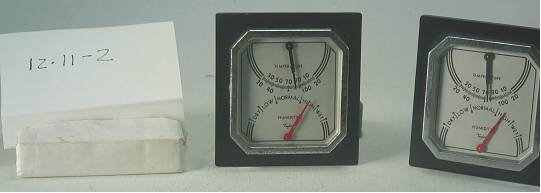Pressure Atomizing Oil Burner Equipment and Systems – Other Components and Parts
A pair of mid 1930’s room temperature and humidity dial read-out devices for locating around the home. With the promotion of coal and oil “winter air conditioning”, new expectations had been established by the Canadian HVACR industry about the winter human “comfort zone” now made possible [See ID#222]. It was a period, too, in which the popular mind was being increasingly bombarded with information on the wonders of modern science and the importance of scientific measurement – if you can’t measure it you can’t control it, Taylor, 1936.
Features:
– Modern styling reflecting the new modernism of the 1930’s, executed in black, red and chrome
Technical Significance:
– The immediate pre W.W.II years was a period of ever increasing expectations about the winter comfort that was now available for the Canadian home – for all those that could afford it. With the development of the forced air furnace, “the winter air conditioner”, came many new possibilities for winter comfort. Included were, automatic combustion control for solid and liquid fuels [coal and oil], automatic room temperature control, air distribution [well beyond that possible with natural convection], constant air circulation. air filtration, as well as automatic humidification. These features would be promoted with great success by the warm air sector of the industry, as a competitive edge, over the “hot water heating systems [hydronic systems] of the times – once considered the preferred type of central heating for all that could afford it.
– By the mid 1930’s many Canadians had become used to the new automated, in-door comforts now possible for the home. They had become used, also, to the glass stem thermometer conspicuously mounted on the wall thermostat and would check it regularly to make sure their heating system was operating properly. But what was new, here, with the advent of the “winter air conditioner”, with forced air circulation, was the suggestion that temperature and humidity conditions should be more or less uniform throughout the entire home, not merely at the thermostat.
– With the marketing and popularization of such remote temperature and humidity measuring devices, homeowners were being invited to check it out for themselves. They were encouraged to purchase a set of scientific air temperature and humidity measuring instruments, make their own scientific measurements and consequently make such changes in the operation of the system, largely by opening and closing registers and dampers, as needed to bring the entire home into one uniform comfort zone. Needless to say many would quickly find the limitations of the new technology – for automatic zone control was still several decades away for most Canadian’s with forced warm air heating systems.
– There was a sense that local heating technicians, such as Howard Oliver, Aurora, in marketing temperature and humidity, dial read-out devices such as these, was inviting the home owner to be part of a new “do it yourself generation”. They were invited to take their own scientific measurements and make their own adjustments, within their own ability and that of the system to respond.
Industrial Significance:
– The 1930’s and 40’s would be a period characterised by much research in the field of in-door human comfort, its necessary and sufficient conditions and the means of creating it in Canada’s climate of weather extremes. Warm air heating research would become a legitimate topic for university, as well as industrial research with technical papers and how-to-do-it manuals to follow. In the field of winter humidity control, for example, see “Winter Air Heating and Winter Air conditioning”, John Norris McGraw-Hill 1950, Chapter 9, Humidity and the properties of Air.
– Characteristic of the period and the emerging market for winter comfort was the creation of the National Warm Air Heating and Air Conditioning Association of Canada [forerunner of the Heating, Refrigeration and Air Conditioning Institute of Canada]. Their extensive set of engineering manuals produced through the 1950’and 60’s would be the standards of the field
– During the 1940’s and 50’s the Howard Furnace Co of Toronto would be an acknowledged leader in the field of winter air conditioning equipment for the Canadian market, see reference. There promotion would read “Enjoy filtered, humidified, gently moving air throughout every part of your home”, “Have even temperature maintained in all rooms with lowest possible fuel costs and little attention”. This was surely new world experience for Canadians approaching the middle years of the 20th century.


